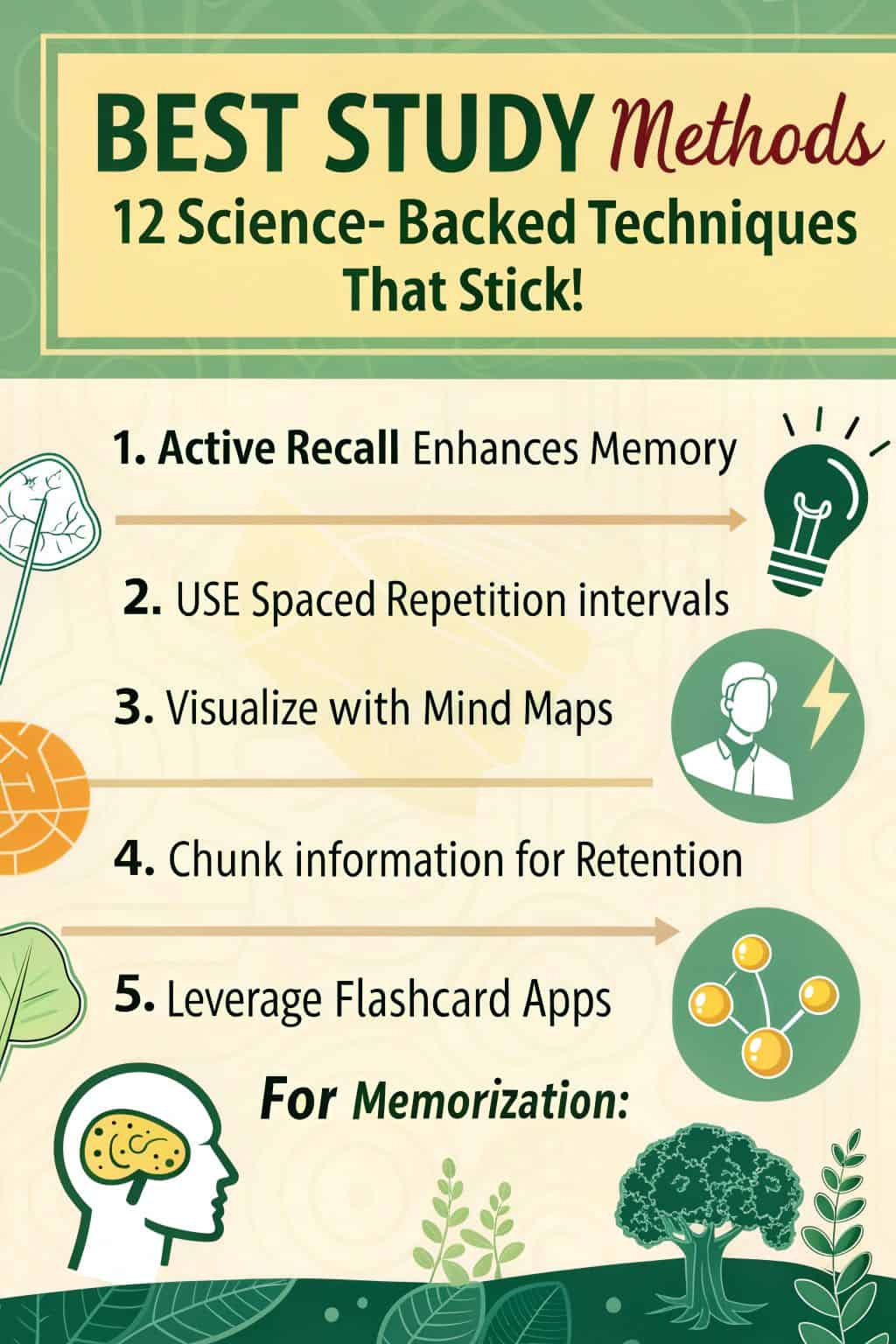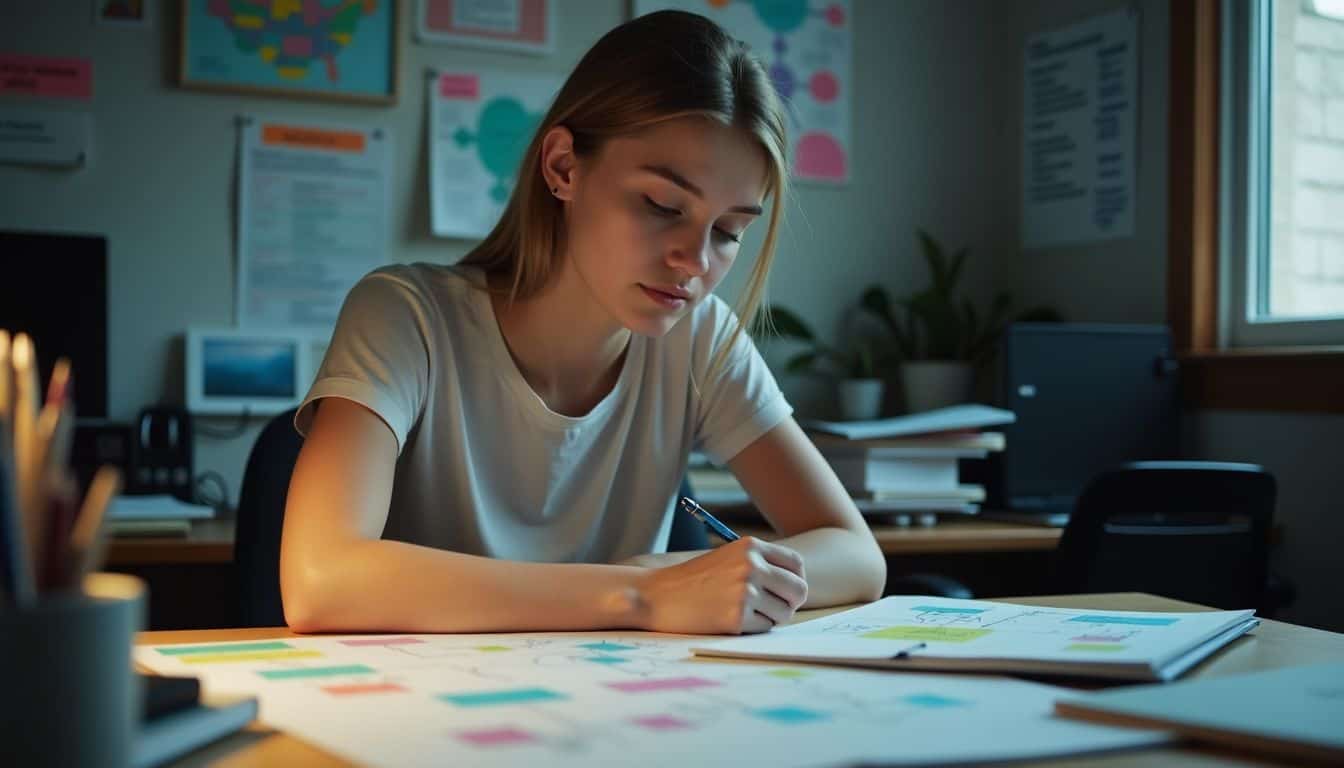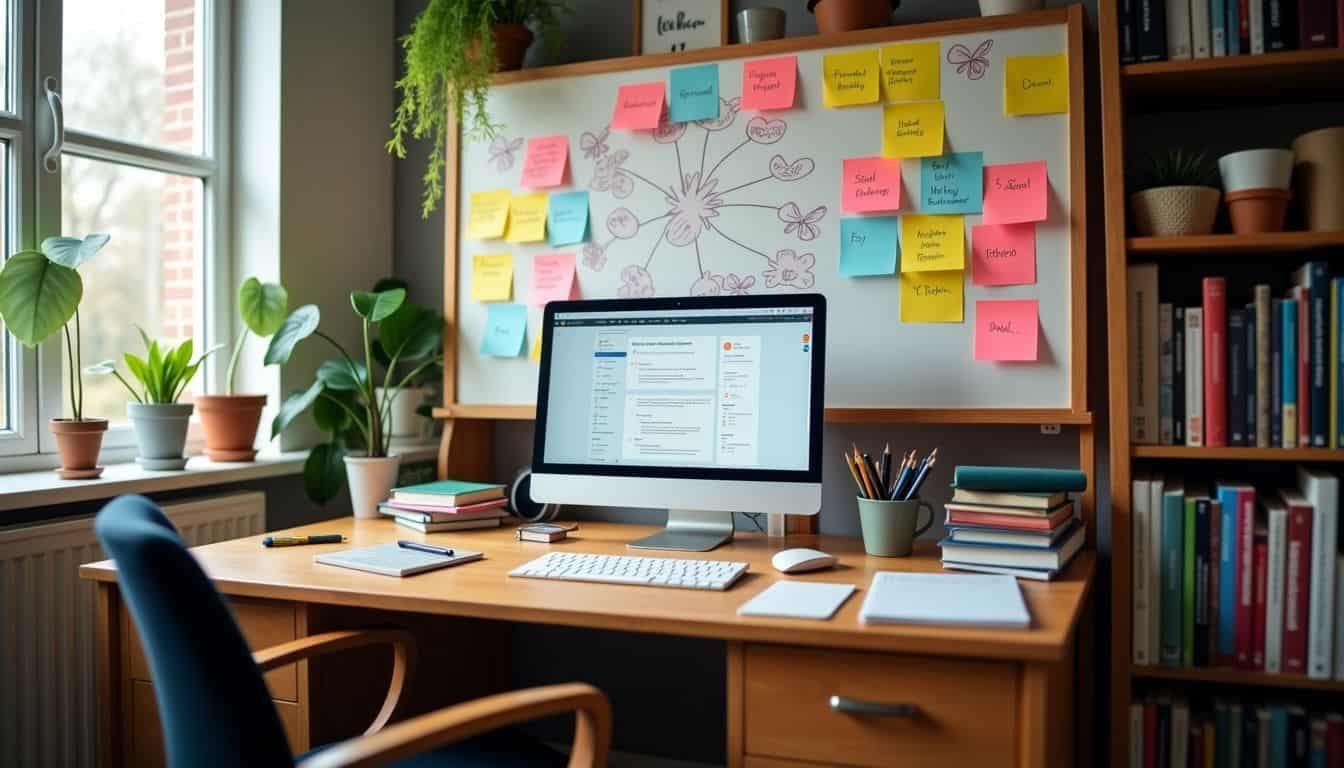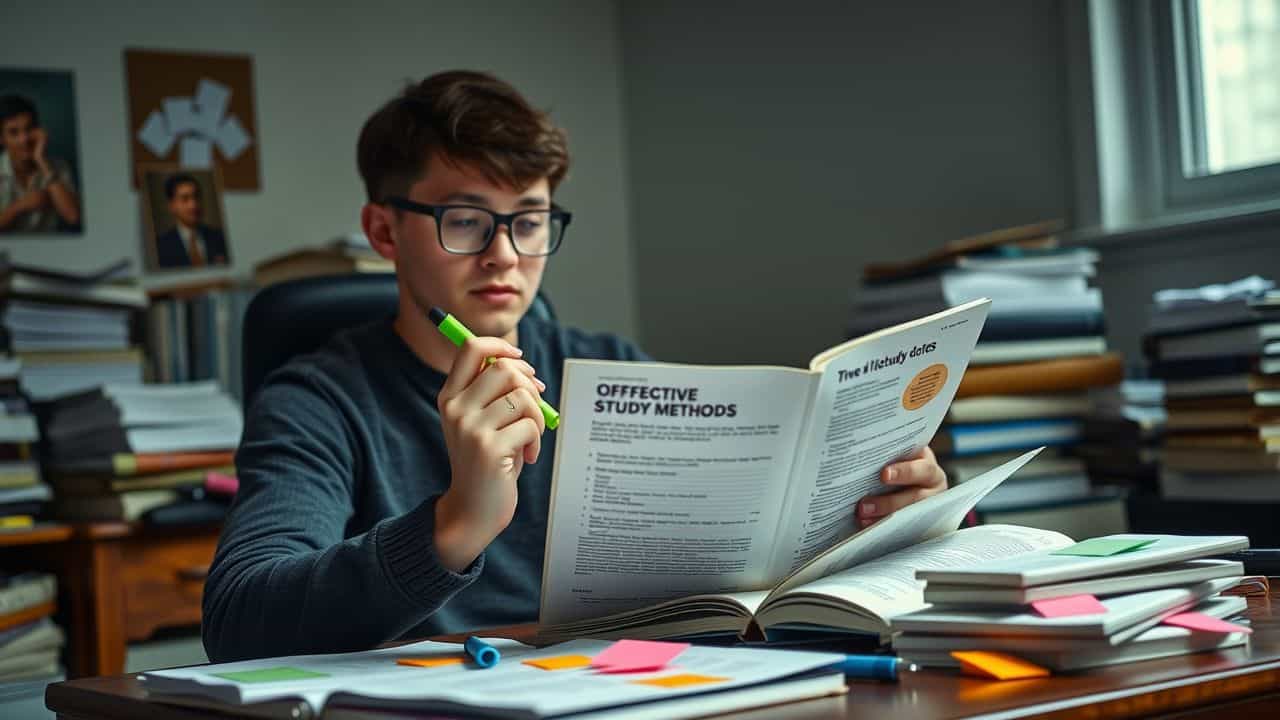Ever feel like your brain’s a sieve when studying? You’re not alone. Research shows that most people forget 50% of what they learn within an hour. But don’t worry! This article will show you the best study methods for memorization.
We’ll explore 12 science-backed techniques that really stick. Ready to supercharge your memory?
Key Takeaways
Active recall and spaced repetition are top memory techniques. Quiz yourself often and review info at set times (1, 7, 16, and 35 days) to boost recall.
Visual methods like mind mapping and the Method of Loci tap into the brain’s strong visual memory. Create mental images or “memory palaces” to remember facts better.
Chunking breaks big info into small bits. Most people can remember 7 things at once, but chunking helps increase this number.
Storytelling and rhymes make dry facts stick. Wrap info in vivid tales or use rhyming pegs to improve memory.
Tools like flashcard apps (e.g. Anki) and educational platforms offer flexible ways to study. They use spaced repetition and let you learn on the go.
Table of Contents
How Memory Functions

Ever wonder how your brain stores all those facts and figures? Let’s peek into the fascinating world of memory. Your mind works like a super-smart computer, processing and filing away info in a flash.
Encoding: Capturing New Information
 Encoding is like taking a mental snapshot. It’s how we grab new info and store it in our brains. Our minds are pretty picky about what they keep, though. They tend to hang onto stuff that’s strange, important, or tied to things we already know.
Encoding is like taking a mental snapshot. It’s how we grab new info and store it in our brains. Our minds are pretty picky about what they keep, though. They tend to hang onto stuff that’s strange, important, or tied to things we already know.
That’s why it’s easier to remember a funny joke than a boring fact.

This quote shows why encoding matters. Our brains can only juggle so much at once. To make new info stick, we need to link it to old knowledge or create vivid mental pictures. It’s like building a bridge between what we know and what we’re learning.
The average person can hold 7 ± 2 items in working memory.
And hey, if you’re struggling with math, don’t worry. There are folks who can give you maths assignment help while you focus on mastering these memory tricks!
Consolidation: Organizing Data

After you take in new info, your brain gets busy. It sorts and files away what you’ve learned. This step is called consolidation. It’s like tidying up your mental desk.
Your brain’s filing system is pretty smart. It links new stuff to old memories. This makes it easier to recall later. The hippocampus – a part of your brain – plays a big role here.
It’s like your brain’s secretary, deciding what to keep and where to put it. As time passes, these memories move to other brain areas for long-term storage. This shift helps protect older memories if the hippocampus gets damaged.
Cool, right? I’ve seen this work in my own life. When I learn new cooking tricks, they stick better if I connect them to recipes I already know.
Storage: Keeping Memories

After our brains organize info, they store it. This step is key for keeping what we learn. Our minds work like file cabinets, tucking away facts for later use. But how well we store info depends on a few things.
Sleep plays a big role in memory storage. It helps lock in what we’ve learned during the day. Writing stuff down also helps. It turns on a part of our brain that boosts recall. Breaking big chunks of info into smaller bits makes it easier to remember too.
And you know what? Teaching others what you know makes your own memory stronger! Tests show that using these tricks can help us recall up to 15 words from a story. That’s way better than just trying to memorize a list.
Retrieval: Accessing Stored Information

Retrieval is like finding a book in a huge library. Your brain stores tons of info, but you need the right “key” to unlock it. This key is often a cue – a smell, sound, or image that sparks your memory.
The more you practice pulling info from your brain, the better you get at it. It’s like working out a muscle!
Memory is the diary we all carry about with us. – Oscar Wilde
Good retrieval skills can make a big difference in your daily life. They help you ace tests, remember names, and keep track of your to-do list. The trick is to create strong connections between new info and stuff you already know.
This makes it easier to find later. Next, let’s check out some proven ways to boost your memory power.
Proven Techniques for Better Memorization

Let’s dive into some killer memory tricks that really work! These methods aren’t just guesswork – they’re backed by science. Ready to supercharge your brain? Keep reading to find out how….
Active Recall

Active recall is a game-changer for memory. It’s like giving your brain a workout! You don’t just read stuff over and over. Instead, you test yourself on what you’ve learned. This method really sticks info in your head.
Studies show it’s super effective – way better than just re-reading your notes.
Here’s the cool part: active recall isn’t hard to do. You can use flashcards, take practice tests, or even explain concepts to yourself out loud. It’s all about pulling info from your brain, not just looking at it.
And guess what? Students who use active recall tend to get better grades. So next time you’re prepping for a big test, don’t just stare at your books. Quiz yourself! And if you need a break, find the best place to study to keep your mind fresh.
Spaced Repetition
 Spaced repetition is a memory technique that really works. It’s like giving your brain gentle reminders to remember information. You study something, then pause before reviewing it again.
Spaced repetition is a memory technique that really works. It’s like giving your brain gentle reminders to remember information. You study something, then pause before reviewing it again.
The magic happens during those breaks. Your brain gets time to process and store the info more effectively. It’s not about cramming – it’s about smart timing.
Here’s the interesting part: there’s a science to the spacing. Research shows the best times to review are 1 day, 7 days, 16 days, and 35 days after you first learn something. Tools like Anki make this straightforward.
It’s a flashcard app that calculates when you should review each card. Pretty clever, right? Let’s explore how visual imagery can improve your memory skills.
Spaced repetition is to learning what compound interest is to investing. – Unknown
Visual Imagery Mnemonics
 Visual Imagery Mnemonics tap into our brain’s love for pictures. They work by turning plain facts into vivid mental images. For example, to remember Baton Rouge as Louisiana’s capital, imagine a girl named Louise twirling a red baton.
Visual Imagery Mnemonics tap into our brain’s love for pictures. They work by turning plain facts into vivid mental images. For example, to remember Baton Rouge as Louisiana’s capital, imagine a girl named Louise twirling a red baton.
This odd scene sticks in your mind better than simple words. I’ve used this trick to ace history exams – it’s like having a personal photo album in your head!
These memory tricks aren’t just fun; they’re backed by science. Our brains have strong visual and spatial memory systems. By using these, we free up our working memory for long-term storage.
It’s like giving your brain extra room to store info. Next, let’s check out how Mind Mapping can boost your study game.
Mind Mapping

Mind mapping is a game-changer for note-taking. It’s like drawing a picture of your thoughts! You start with a main idea in the center, then branch out with related concepts. This method helps break down big chunks of info into bite-sized pieces.
It’s not just about writing stuff down – it’s about making connections. I’ve found that mind maps make studying way more fun and less of a chore.
Here’s the cool part: mind maps can boost your reading skills too. They train your brain to spot important details and link them together. It’s like giving your mind a workout while you learn.
Plus, it’s a great way to get creative with your studies. You can use colors, symbols, or even little doodles to make your map pop. Trust me, once you try it, you’ll wonder how you ever studied without it!
The Method of Loci
Moving from mind mapping, let’s check out another powerful memory technique. The Method of Loci, also called the memory palace, is a game-changer for memorization. It’s an old trick from 80 B.C., first mentioned in a text called “Rhetorica ad Herennium”.
This method uses your spatial memory to boost recall. Here’s how it works: you choose a familiar place, like your home, and mentally put items you want to remember in specific spots.
When you need to recall, you just take a mental walk through your chosen space. It’s like hiding Easter eggs in your mind!
The Method of Loci is a technique that takes you through your own mental landscape.
Joshua Foer, a memory champion, used this method to get ready for the U.S. Memory Championship. But it’s not just for experts. You can use it too! Try this: next time you need to remember a grocery list, imagine putting each item in different rooms of your house.
Milk in the fridge, bread on the coffee table, eggs on your pillow. Sounds weird, right? But it works! The more vivid and silly your mental images, the better you’ll remember. It’s a fun way to turn your mind into a storage space for facts and figures.
Advanced Strategies for Effective Memorization

Ready to level up your memory game? Let’s dive into some cool tricks that’ll make info stick like glue in your brain! These aren’t your grandma’s study methods – they’re the big guns of memorization.
Trust me, you’ll want to keep reading….
Chunking Technique
Chunking is a clever way to learn. It breaks big info into small, easy bits. Think of it like sorting candy into piles. Each pile is easier to count and remember. Our brains love this trick! It helps us hold more in our heads at once.
Most folks can keep 7 things in mind. But with chunking, we can boost that number.
I use chunking all the time. It’s great for phone numbers, shopping lists, and study notes. Instead of a long string of digits, I group them. 555-123-4567 is way easier than 5551234567.
For my grocery list, I chunk by aisle. It makes shopping quick and easy! This method cuts down on brain strain. It’s a real game-changer for learning tough stuff. Next up, we’ll look at another cool memory hack: acronyms and acrostics.
Acronyms and Acrostics
Moving from chunking, let’s chat about two more fun memory tricks: acronyms and acrostics. These tools make remembering lists easy. Acronyms use the first letters of words to form a new word.
For example, “PAIN” helps you recall fossil types: Actual Remains, Petrified, Imprints, and Molds or Casts. Acrostics, on the other hand, create a sentence from those first letters.
Math fans might know “My Dear Aunt Sally” for order of operations. Both methods tap into your brain’s love for patterns, making tough info stick easily.
These tricks focus on quick recall, not deep understanding. They’re great for busy moms, students, or anyone with a packed schedule. Your brain will appreciate these mental shortcuts! Just pick a word or phrase that resonates with you, and there you have it – instant memory boost.
Try it out on your next to-do list or while prepping for a big meeting. You’ll be surprised at how much easier it is to remember key points.
Storytelling Strategy
Stories stick with us. They grab our hearts and minds, making facts easier to remember. Think of a time when a friend told you a funny tale. You likely still recall it, right? That’s the power of storytelling for memory.
It works because our brains love patterns and emotions. When we wrap dry info in a juicy story, it becomes more than just facts. It turns into a vivid movie in our heads.
Let’s apply this to your studies. Say you need to learn about cell parts. Instead of just listing them, create a story. The nucleus could be the boss of a tiny city (the cell). The mitochondria are the power plants, keeping everything running.
Suddenly, those boring terms come alive! This method works great for history, science, and more. It’s a fun way to make learning stick. Next, we’ll look at how to break big chunks of info into smaller, easier bits.
Rhyming and Mnemonic Pegs
Rhymes and pegs can make learning fun! Think of them as memory helpers. They help you connect new info to stuff you already know. Let’s say you need to remember a list. You can link each item to a number that rhymes with it.
For example, “one” rhymes with “gun,” “two” with “shoe,” and “three” with “bee.” Now, imagine these things in your mind. The stranger the image, the better you’ll remember it.
Want to step it up? Add in a memory palace. This is a place you know well, like your home. As you walk through it in your mind, place your rhyming images in different spots. Now you’ve got a double boost of memory power! It might seem strange, but it works.
Your brain loves connections and pictures. So give it what it wants, and watch your recall improve.
Tools and Resources to Aid Memorization

Let’s chat about some awesome gadgets that’ll make remembering stuff super easy. These tools are like your brain’s BFFs – they’ll help you store info and bring it back when you really need it.
Flashcards
Flashcards pack a punch for learning. They’re not just for kids – grown-ups use ’em too! Med students swear by Anki, a digital flashcard app, to ace their exams. Studies show Anki users score way higher than those who don’t.
It’s like having a secret weapon for your brain.
But wait, there’s more! Old-school paper flashcards still rock. The Leitner System sorts cards into boxes based on how well you know ’em. It’s like giving your memory a workout. And get this – using flashcards is linked to better grades and test scores.
So grab some index cards or download an app… your brain will thank you!
Memory Apps
Memory apps are game-changers for studying. They let you learn on the go, fitting study time into your busy day. Got five minutes while waiting for coffee? Pull out your phone and review some flashcards.
These apps track your progress too, so you know what you’ve mastered and what needs more work.
I’ve tried a bunch of these apps myself. Anki is my favorite – it’s super flexible. You can make your own cards or download pre-made decks. The spaced repetition feature is great. It shows you cards right when you’re about to forget them.
This helps move info into your long-term memory. Next up, let’s look at some old-school memory tricks that still work wonders.
Educational Platforms
Educational platforms offer a wealth of tools for better memorization. These online spaces pack tons of features to boost your learning. You’ll find flashcards, quizzes, and games that make studying fun.
Many use spaced repetition to help you review info at the right times. This method fights against forgetting and helps lock facts into your long-term memory.
Some popular platforms even let you create your own study materials. You can make custom flashcards or share notes with friends. The best part? You can access these tools anywhere – on your phone, tablet, or computer.
It’s like having a personal tutor in your pocket! With these digital helpers, you’ll find it easier to tackle tough subjects and ace your exams.
People Also Ask
What are some top-notch memorization techniques for boosting study skills?
Science-backed methods like spaced repetition, mind palaces, and mnemonic devices can work wonders. These tricks help fight the forgetting curve and strengthen your brain’s ability to store info for the long haul.
How can I improve my short-term memory for better learning?
Try working memory training exercises. They’re like push-ups for your brain! Also, use visualization and creativity to make boring facts stick. Picture that boring history date as a wild party scene – it’ll be hard to forget!
What’s the deal with “highly superior autobiographical memory” (HSAM)?
HSAM is like having a superpower for remembering life events. While most of us struggle to recall what we had for breakfast, folks with HSAM can tell you what they wore on a random Tuesday years ago. It’s rare, but studying it helps us understand human memory better.
Can language learning boost my memory skills?
You bet! Learning a new language, like mastering the passé composé in French, is a fantastic workout for your noggin. It builds cognitive skills and can even help ward off forgetfulness as you age. Plus, you’ll sound fancy ordering croissants!
Are there any quick memory hacks for nursing assistants?
Absolutely! Try acronyms like “Please Excuse My Dear Aunt Sally” for remembering steps in patient care. Visual memories work great too – picture each task as part of a story. These tricks can be lifesavers when you’re juggling a busy to-do list on the ward.
How does mental health affect memory and learning?
Your mental well-being plays a huge role in cognitive performance. Stress, anxiety, and poor sleep can mess with your ability to focus and remember stuff. Taking care of your mental health isn’t just good for your mood – it’s crucial for keeping your memory sharp as a tack!
References
https://nobaproject.com/modules/memory-encoding-storage-retrieval
https://pmc.ncbi.nlm.nih.gov/articles/PMC4526749/
https://irisreading.com/what-is-the-best-memory-strategy/
https://www.usa.edu/blog/science-backed-memory-tips/
https://pubmed.ncbi.nlm.nih.gov/38461899/
https://collegeinfogeek.com/spaced-repetition-memory-technique/ (2020-07-17)
https://www.researchgate.net/publication/373673706_MNEMONICS_-_MEMORY_METHODS_FOR_MORE_EFFECTIVE_LEARNING (2023-10-20)
https://www.nytimes.com/2016/03/24/upshot/an-ancient-and-proven-way-to-improve-memory-go-ahead-and-try-it.html (2016-03-24)
https://www.talentcards.com/blog/chunking-memory/ (2024-03-27)
https://thembatutors.com/acronyms-and-acrostics-techniques/
https://learningcenter.unc.edu/tips-and-tools/enhancing-your-memory/
https://www.amazon.com/Make-Stick-Science-Successful-Learning/dp/0674729013
https://www.magneticmemorymethod.com/peg-system/
https://www.ncbi.nlm.nih.gov/pmc/articles/PMC10403443/
https://learningbox.online/en/2022/03/11/blog-15-memory-method/ (2022-03-11)
